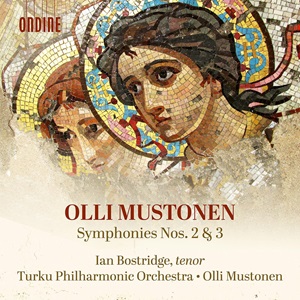
Olli Mustonen (b. 1967)
Symphony No 3 ‘Taivaanvalot’ (Heavenly Lights) (2020)
Symphony No 2 ‘Johannes Angelos’ (2013)
Ian Bostridge (tenor), Turku Philharmonic Orchestra/Composer
rec. 2022 (Symphony No 3) and 2023 (Symphony No 2), Turku Concert Hall, Finland
English and Finnish text included
Ondine ODE1422-2 [64]
As I greatly enjoyed the versatile Finnish pianist, composer and conductor Olli Mustonen’s first string quartet (review review), I was pleased to receive this disc of two of his symphonies. Mustonen began as a pianist and has made a number of recordings in that capacity. However, he has been working as a composer for nearly thirty years and more recently has also been active as a conductor and is indeed the Artistic Director of the Turku Philharmonic, which he conducts in his own works here.
These two symphonies are presented in reverse chronological order, but I shall discuss them in their composition order. The second symphony is a programmatic work, based on the fall of Constantinople to the Ottoman Turks in 1453. It had been founded as the capital of the Eastern Roman Empire by Constantine in 330 and had continued in that capacity for a nearly a millennium after the fall of the Western Empire. It was Greek speaking, but still considered itself Roman; nowadays, we refer to its empire and culture as Byzantine. The immediate inspiration was a 1952 novel, ‘Johannes Angelos’, also known as ‘The Dark Angel,’ by the Finnish writer Mika Waltari, and the symphony takes its title from this.
The title character meets his love Anna in the last days of the city, but they both die in its fall. There are four movements. The first, ‘The Panagia of Blachernae’ is a slow, meditative piece, beginning with harp and strings, over which an alto flute, a cor anglais and a bassoon successively offer a plaintive motif. Later, a quicker motif suggests anxiety. This is followed by ‘St Spyridon’s Day,’ Over a pounding rhythm on the timpani the brass issue challenges and we settle down to a vigorous Allegro. A lyrical passage evokes the love between Johannes and Anna, but the Allegro returns and becomes increasingly urgent. ‘At the Church of the Holy Apostles’ features the people both desperate and preparing for battle; the church was the second most important in the city after Hagia Sophia. This is the longest movement, and it moves through a variety of moods, though the main one is that of lament. The finale, ‘Aleo e polis’ (the city is lost) describes the fall with, at one point, a ringing of all the bells in the city.
There is an epilogue in which the lovers meet in the afterlife and a hymn celebrates the heritage of the city. What actually happened was that the successful invaders carried out three days of looting and they demolished the Church of the Holy Apostles.
The third symphony, whose title in English is ‘Heavenly Lights,’ is a work for solo tenor and orchestra, and it dramatizes a legend from the Finnish national epic the Kalevala, known to musicians for the use Sibelius and others made of it. Fortunately for English-speaking listeners, Mustonen uses, not the original Finnish, but the English translation by Keith Bosley, apart from the ending where he uses Finnish. The story features the wizard Väinämöinen, the witch Louhi, mistress of Pohjola, the North Land, and the smith Ilmarinen. Louhi manages to imprison the sun and the moon, and the land grows bleak and cold. Väinämöinen directs Ilmarin to forge tools with which he will release the sun and the moon. Louhi sets off in bird form to Ilmarin and he tells her he is forging a collar with which to imprison her. This is enough to persuade her to release the sun and the moon and she invites Väinämöinen to go and see them back in the sky. The work ends with him greeting them in Finnish.
This is a good story, and the work plays continuously in expounding it, though for convenience four tracks are identified. The music is always engaging, and I particularly liked that for the smith Ilmarin. I did wonder whether it was really too episodic to count as a symphony, but that is perhaps a matter of taste.
The performances under the composer are obviously authoritative and the orchestra plays well for him. The soloist in the third symphony is our old friend Ian Bostridge, whose sensitive and flexible singing is always a pleasure. He handles the Finnish at the end with aplomb and I presume Mustonen, as a native speaker, was satisfied. The recording is up to Ondine’s usual high standard. The booklet outlines the stories and gives the text of the third symphony in both English and Finnish. If I tend to prefer the second symphony to the third, it is because it seems to me more successfully integrated, but both works are worth hearing and Mustonen is worth following.
Stephen Barber
Help us financially by purchasing from




















